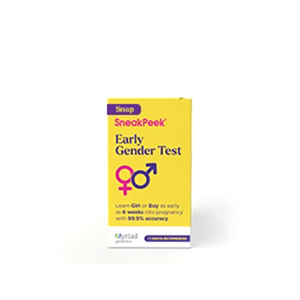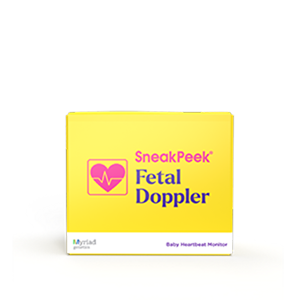Published on August 3rd, 2022 and Updated on April 11th, 2024
Check out SneakPeek Gender Test to find out your baby’s gender as early as 6 weeks at over 99% accuracy1!
If you’ve always dreamed of growing a family, you may be eager to start adding more branches to your tree right after your first precious gift arrives. But, before you read up on how to get pregnant fast, is it safe to repeat this physical journey right away?
When it comes to timing pregnancies, personal preference is one big factor. However, there are also medical risks to consider with back-to-back pregnancies. Medical professionals recommend waiting 18 months or more between pregnancies. By waiting, you can best support your body (and your baby) through your second pregnancy.
Curious to learn more about timing the branches of your family tree? Let’s explore the medical advice, risks, and statistics around second pregnancies.
Interpregnancy 101: How long should you wait?
The time between pregnancies is called interpregnancy—and it’s an important period for both you and your future little one.
Also known as birth spacing, interpregnancy can shape the health of your next pregnancy. Rush into a second pregnancy, and you could run into medical risks and pregnancy complications for you and your baby. Wait for years and years, and your fertility might drop. So, where’s the sweet spot?
The American College of Obstetricians and Gynecologists recommends waiting at least six months between pregnancies—although 18 months or longer is preferred. Layered on top of this is a recommendation to attempt a second pregnancy before reaching 37 years old, as this is the age when fertility begins to decline significantly.
Threading the needle on this time range when attempting your second pregnancy can help you:
- Restart regular ovulation – Outside of pregnancy, premenopausal women ovulate (or release a ready-to-go egg from their ovaries) about every month. However, post-pregnancy ovaries need a little time to get back into the swing of things. Women may begin ovulating again anywhere from 45 to 94 days after delivery, whether this may be vaginal delivery or through cesarean section. Additionally, if you exclusively breastfeed following delivery, your ovulation and menstrual cycle will be delayed until you stop.
- Heal physically – Being pregnant and giving birth is no small task. From feet swelling to weight gain, your body goes through a whirlwind of changes over those nine months and needs time to recover. Additionally, pregnancy and breastfeeding both rely on nutrient stores in your body, so allowing ample recovery time between pregnancies can help your body replenish those nutrients for a healthy second child. In fact, this is why your body will continue to pause your ovulation if you breastfeed—it knows you need every bit of energy for your first baby, not another pregnancy.
- Maintain fertility – Experts state that female fertility begins declining by 32 years old, and by 37 years old, this decline picks up speed. This is due to a decrease in egg count (the total number of eggs in your ovaries) and egg quality (the chromosomal normality of your eggs). So, if you wait until your late-30’s to have a second pregnancy, you may face fertility issues.
- Prevent birth defects and risks – The fewer months you wait between your first and second pregnancies, the more health issues you risk, such as premature delivery and congenital disorders. The less time you wait, the more stress and systematic inflammation your body experiences—big no-no’s for a healthy pregnancy. This is why medical experts recommend an interpregnancy interval of no less than six months.
What are the risks of an early second pregnancy?
Back-to-back pregnancies may seem efficient, but there are reasons to wait a little longer. Medical research shows that second pregnancies begun less than six months after a live birth correlate with birth defects or fetal health conditions, like:
- Premature birth (before 37 weeks)
- Low birth weight
- Partial or full placental abruption (when the placenta peels away from the uterine wall)
- Schizophrenia (in the baby)
- Congenital disorders, such as Down syndrome and cleft lips
- Autism
What creates these health risks for back-to-back pregnancies?
Overall, the risks of birth defects and pregnancy complications stem from a lack of recovery. When your body hasn’t returned to its pre-pregnancy health, it sets a poor foundation for your next child to develop. Experts believe these three physical factors need at least six months to rebalance for a healthy second pregnancy:
- Nutrient supply – Does everything you eat go to your baby? From vitamin D to calcium, the nutrients your baby receives will come mostly from your body. Particularly, sufficient folic acid is necessary for healthy cellular development in fetuses. Without nutritional replenishment between pregnancies, your baby could develop neural tube defects, arrive prematurely, or have a low birthweight. Additionally, depleted iron levels can leave moms anemic between close pregnancies.
- Inflammation – During pregnancy, many conditions can create inflammation in the body, such as endometritis (an inflamed lining of the uterus) or even stress. Higher inflammation levels correlate with fetal brain development issues, as well as premature labor. To decrease the likelihood of these risks, it’s important to give your body time to reduce inflammation before a second pregnancy.
- Vaginal microbiome – Not all bacteria are bad. In fact, the microbiome (or group of bacteria) inside your vaginal canal is crucial for your health! However, pregnancy changes your vaginal microbiome, and experts say it can take up to a year for the vaginal microbiome to recover after pregnancy. If you don’t allow your vaginal microbiome the time it needs to return to its pre-pregnancy state, you increase the likelihood of developing infections that correlate with premature births.
Is conceiving a second child easier?
Once you’re ready to try for another baby, you may wonder, “what’s the average time to get pregnant with a second child?” Will getting back into those maternity pants take less time now that your body is a pregnancy pro?
The answer is maybe. It all depends on your personal fertility level.
There’s no clear evidence on how the number of pregnancies affects fertility. Whether it’s your first or fourth pregnancy, your odds of conception may be high or low. In fact, secondary infertility (or having trouble conceiving a second child) occurs in 10% of trying couples—about the same rate as primary infertility.
Other genetic and behavioral traits do play a significant role in your fertility. If you’re trying to get pregnant a second time, these fertility factors make an impact:
- Age – As stated earlier, older women have a harder time getting pregnant. In your early 20’s, you have about a 1 in 4 chance of getting pregnant every month. By age 40, those odds decline to 1 in 20. However, this doesn’t mean you’re out of luck! In fact, within a year of trying to conceive, about 85% of women under 37 years old will get pregnant.
- Weight – A healthy body weight is important for all aspects of life, including fertility. Studies show that overweight and underweight BMIs correlate with lower fertility than normal BMIs.
- Diet – Proper nutrient intake is the key to healthy hormone levels, which in turn, affect your fertility. That’s why women who eat balanced diets full of important nutrients are more fertile than those who eat highly-processed diets that lack these nutrients. Particularly, antioxidants like vitamin C, zinc, and folate are crucial for fertility as they can protect the quality of your eggs. In fact, one of the ways how to improve egg quality is eating foods rich in omega-3.
- Physical activity – Studies show that moderate physical activity can boost fertility in overweight women. However, exercise runs on a bell curve with pregnancy. If you rely on high-intensity workouts, you might actually lower your fertility.
- Alcohol intake & tobacco usage – Is drinking wine while pregnant bad? Research suggests that high alcohol consumption and regular smoking both lower conception rates. Smoking cuts off the blood supply to your ovaries, possibly reducing egg quality.
- Stress – Up all night running through your to-do lists? All that anxious energy may be detracting from the work of your ovaries. Stress offsets the delicate hormonal balance run by your hypothalamus, pituitary gland, and adrenal glands, which can hinder ovulation. Fortunately, studies show that stress reduction can boost conception rates.
If you experienced fertility issues during your first pregnancy, it’s likely you’ll experience them again the second time around. Only about 17% of mothers who initially conceived with IVF (in vitro fertilization) will naturally conceive a future child. Consider speaking with your fertility specialist or medical provider about fertility support when trying for baby number two.
What’s the average time between first and second pregnancies?
It’s hard not to play the comparison game when planning a second pregnancy, but keep in mind that there’s no “right” way to plan a family. A healthy gap between pregnancies can be as short as 18 months or as long as over a decade! What matters most is that your pregnancy is safe.
Still curious about pregnancy timelines? Check out these statistics from a 2016 survey conducted by the Centers for Disease Control and Prevention (CDC) about U.S. families:
- The median interpregnancy interval was 24 to 29 months
- Out of all interpregnancy intervals, only 4.8% were shorter than 6 months
- After an initial pregnancy, nearly 29% of mothers took less than 18 months to start another pregnancy
- For older women and mothers over 35 years old, interpregnancy intervals between 12 and 17 months were more common (22.1%) than for younger mothers (8.4%)
- Less than 5% of births occurred after an interpregnancy interval of 10 years or longer.
If you already have another child on the way, learn how to prepare your toddler for a new baby sibling as your family grows!
Plan Your Family Tree with SneakPeek
Once the second branch of your family tree has sprouted, you can use the SneakPeek At-Home Early Gender Prediction Test to meet your newest member sooner than ever before.
Discover the sex of your baby as early as six weeks into your pregnancy. That’s months ahead of your 20-week anatomy scan ultrasound! Plus, our #1 OBGYN-recommended Gender Blood Test comes with over 99% clinically proven accuracy1, as well as a money-back guarantee if your results don’t match the sex of your baby.
If you’re ready to jump back into those stretchy pants, we’re ready to come with you. Join the 1 million moms who discovered their baby’s gender sooner by saying yes to SneakPeek Test.
This post has been reviewed for accuracy by the following medical professional:
Katie Smith is a seasoned Certified Nurse Midwife and a nurturing mother to six children, offering a unique blend of professional expertise and personal experience. She is the founder of Birth Your Way Midwifery and Women’s Wellness Center in Bay County, Florida. Katie's comprehensive approach to care is informed by her hands-on experience in motherhood and her passion for empowering women through their birthing journey. Her dedication extends beyond her center as she actively engages in community wellness and family health education.
Sources:
- American College of Obstetricians and Gynecologists. Interpregnancy Care.
- https://www.acog.org/clinical/clinical-guidance/obstetric-care-consensus/articles/2019/01/interpregnancy-care
- American College of Obstetricians and Gynecologists. Female Age-Related Fertility Decline. https://www.acog.org/clinical/clinical-guidance/committee-opinion/articles/2014/03/female-age-related-fertility-decline
- NIH. The Importance of Antioxidant Micronutrients in Pregnancy. https://www.ncbi.nlm.nih.gov/pmc/articles/PMC3171895/
- Better Health. Weight, fertility and pregnancy health. https://www.betterhealth.vic.gov.au/health/conditionsandtreatments/age-and-fertility
- Better Health. Age and fertility. https://www.betterhealth.vic.gov.au/health/conditionsandtreatments/weight-fertility-and-pregnancy-health
- CDC. Short Interpregnancy Intervals in 2014: Differences by Maternal Demographic Characteristics. https://www.cdc.gov/nchs/products/databriefs/db240.htm
- March of Dimes. Bacterial vaginosis and pregnancy. https://www.marchofdimes.org/complications/bacterial-vaginosis.aspx
- Mayo Clinic. Family planning: Get the facts about pregnancy spacing. https://www.mayoclinic.org/healthy-lifestyle/getting-pregnant/in-depth/family-planning/art-20044072
- NIH. Association of western diet & lifestyle with decreased fertility. https://www.ncbi.nlm.nih.gov/pmc/articles/PMC4345758/
- NIH. Changes in the Vaginal Microbiome during the Pregnancy to Postpartum Transition. https://www.ncbi.nlm.nih.gov/pmc/articles/PMC8189965/
- NIH. Effects of alcohol consumption on female fertility during an 18-year period. https://pubmed.ncbi.nlm.nih.gov/14967377/
- NIH. How effective are weight-loss interventions for improving fertility in women and men who are overweight or obese? A systematic review and meta-analysis of the evidence. https://pubmed.ncbi.nlm.nih.gov/28961722/
- NIH. The Hypothalamic-Pituitary-Adrenal Axis: A Brief History. https://pubmed.ncbi.nlm.nih.gov/29719288/
- NIH. The impact of female obesity on the outcome of fertility treatment. https://www.ncbi.nlm.nih.gov/pmc/articles/PMC2970793/
- NIH. The relationship between stress and infertility. https://www.ncbi.nlm.nih.gov/pmc/articles/PMC6016043/
- NIH. The risk of maternal nutritional depletion and poor outcomes increases in early or closely spaced pregnancies. https://pubmed.ncbi.nlm.nih.gov/12730491/
- Obstetrics & Gynecology. Return of Ovulation and Menses in Postpartum Nonlactating Women. https://journals.lww.com/greenjournal/Abstract/2011/03000/Return_of_Ovulation_and_Menses_in_Postpartum.20.aspx
- Oregon Health & Science University. Study confirms that inflammation during pregnancy is linked to baby’s brain. https://news.ohsu.edu/2018/04/09/study-confirms-that-inflammation-during-pregnancy-is-linked-to-babys-brain
- Parents. 25 Tips to Get Pregnant, According to Experts. https://www.parents.com/getting-pregnant/trying-to-conceive/what-docs-want-you-to-know-25-tips-to-get-pregnant-faster/
- Reuters. After IVF, some couples get pregnant without help. https://www.reuters.com/article/us-after-ivf-pregnant/after-ivf-some-couples-get-pregnant-without-help-idUSBRE84212L20120503
- Today. Here’s what you should know about secondary infertility. https://www.today.com/parents/secondary-infertility-learn-about-causes-treatments-t151986
- Planned Parenthood. Breastfeeding. https://www.plannedparenthood.org/learn/birth-control/breastfeeding

Shop Our Products
SneakPeek aims to provide the most accurate and up-to-date information to help our readers make informed decisions regarding their health before, during, and after pregnancy. This article was written based upon trusted scientific research studies and/or articles. Credible information sources for this article are cited and hyperlinked.






